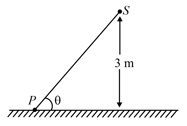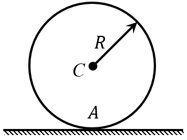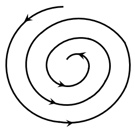Uniform Circular Motion
Uniform Circular Motion: Overview
This topic consists of various concepts like Uniform Circular Motion,Centripetal Acceleration,Kinematics of Circular Motion, etc.
Important Questions on Uniform Circular Motion
Two particles of mass M and m are moving in a circle of radii R and r. If their time – periods are same, what will be the ratio of their linear velocities?
What is the linear velocity if the angular velocity vector is and position vector is ?
A body is whirled in a horizontal circle of radius 20 cm. It has an angular velocity of What is its linear velocity at any point on circular path
When a body moves with a constant speed along a circle
A particle of mass M is moving in a horizontal circle of radius R with uniform speed V. When it moves from one point to a diametrically opposite point, its :
A hemispherical bowl of radius is rotating about its own axis (which is vertical), with an angular velocity . A particle of mass on the frictionless inner surface of the bowl is also rotating with the same . The particle is at a height from the bottom of the bowl.
Obtain the relation between and . What is the minimum value of needed, in order to have a non-zero value of ?
An electric line of force in the plane is given by the equation . A particle with unit positive charge, initially at rest at the point in the plane, will move along the circular line of force.
Spotlight rotates in a horizontal plane with a constant angular velocity of . The spot of light moves along the wall at a distance of . The velocity of the spot when (see. fig.) is

Why is centrifugal force considered as an imaginary force?
A body of mass is moving with speed along a circular path of radius . Now, the speed is reduced to and radius is increased to . For this change, initial centripetal force needs to he
A particle is moving in a circle of radius with a constant speed . Its average acceleration over the time when it moves over half the circle is :
Two identical particles each of mass go round a circle of radius under the action of their mutual gravitational attraction. The angular speed of each particle will be :
A merry-go-round rotates from rest with constant angular acceleration . Ratio of time to rotate first 2 revolutions and next 2 revolutions is
A child of mass is going round a merry-go-round that makes rotation in . The radius of the merry-go-round is . The centrifugal force on the child will be
A particle is moving with constant speed in a circular path. When the particle turns by an angle the ratio of instantaneous velocity to its average velocity is The value of will be
A disc of radius rolls on a rough horizontal surface. The distance covered by the point A in one revolution is:
Vikas is driving a car of mass m along a circular path of radius The coefficient of static friction between the path and tyres of the car is .The maximum speed with which he can drive the car without slipping is ( is acceleration due to gravity)
A particle is moving on a spiral path as shown in the figure. The speed of particle remains constant.
In circular motion speed depends on angular position as . The value of as a function of time is
A phonograph turn-table rotating at slows down and stops in after the motor is turned off. Then the revolutions made by it in this time are


